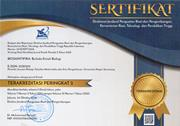Genetic Diversity and Relationships of Phalaenopsis Based on the rbcL and trnL-F Markers: In Silico Approach
(1) Laboratory of Genetics and Molecular Biology, Faculty of Mathematics and Natural Sciences, Universitas Lambung Mangkurat, Indonesia
(2) Laboratory of Genetics and Molecular Biology, Faculty of Mathematics and Natural Sciences, Universitas Lambung Mangkurat, Indonesia
(3) Laboratory of Genetics and Molecular Biology, Faculty of Mathematics and Natural Sciences, Universitas Lambung Mangkurat, Indonesia
(4) Laboratory of Genetics and Molecular Biology, Faculty of Mathematics and Natural Sciences, Universitas Lambung Mangkurat, Indonesia
Abstract
In silico is the more comprehensive and applicable approach in supporting, both conservation and breeding programs of germplasm. The study aimed to analyze and determine the genetic diversity and relationships of 24 species of Phalaenopsis using two DNA barcoding markers, namely the rbcL and trnL-F, by in silico approach. All sequences of these markers were collected randomly from the NCBI website and analyzed using several softwares and methods, such as ClustalW and MultAlin for multiple sequence alignments and MEGA-X to determine its genetic diversity and relationships. Specifically, the genetic diversity was determined using a nucleotide diversity index and their relationships by the Maximum Likelihood method. The results showed that Phalaenopsis has a low genetic diversity of 0.24, 0.32, and 0.19, respectively. The phylogenetic analysis revealed that this orchid separated into five (for the rbcL), six (trnL-F), and seven clades (a combined one), where the closest relationship is shown by P. amboinensis vs. P. venosa, whereas the farthest by P. gibbosa vs. P. doweryensis, P. stuartiana vs. P. micholitzii, and P. celebensis vs. P. pulchra. The results have novel information on the diversity and relationships of Phalaenopsis on the in silico approach. Thus, our findings might be used in supporting the conservation and breeding program of Phalaenopsis, both locally and globally.
Keywords
Full Text:
PDFReferences
Acquaah, G. (2012). Principles of plant genetics and breeding. John Wiley and Sons. Oxford, UK: Wiley-Blackwell. https://doi.org/10.1002/9781118313718
Aloqalaa, D. A., Kowalski, D. R., Bła, P., & Wnetrzak, M. (2019). The impact of the transversion/transition ratio on the optimal genetic code graph partition. In 12th International Conference on Bioinformatics Models, Methods and Algorithms (pp. 55–65). Prague, Czech Republic.
CBOL, P. W. G. (2009). A DNA barcode for land plants. PNAS, 106(31), 12794–12797.
Chang, Y. K., Veilleux, R. E., & Iqbal, M. J. (2009). Analysis of genetic variability among Phalaenopsis species and hybrids using amplified fragment length polymorphism. Journal of the American Society for Horticultural Science, 134(1), 58–66. https://doi.org/10.21273/jashs.134.1.58
Chen, C., & Lin, R.-S. (2012). CO2 uptake patterns in Phalaenopsis amabilis. African Journal of Agricultural Research, 7(1), 128–141. https://doi.org/10.5897/ajar11.1221
Chen, C. W., Huang, Y. M., Kuo, L. Y., Nguyen, Q. D., Luu, H. T., Callado, J. R., … Chiou, W. L. (2013a). TrnL-F is a powerful marker for DNA identification of field vittarioid gametophytes (Pteridaceae). Annals of Botany, 111, 663–673. https://doi.org/10.1093/aob/mct004
Chen, W. H., Kao, Y. L., Tang, C. Y., Tsai, C. C., & Lin, T. Y. (2013b). Estimating nuclear DNA content within 50 species of the genus Phalaenopsis Blume (Orchidaceae). Scientia Horticulturae, 161, 70–75. https://doi.org/10.1016/j.scienta.2013.06.045
Chung, Y. L., Kuo, Y. T., & Wu, W. L. (2017). Development of SSR markers in Phalaenopsis orchids, their characterization, cross-transferability and application for identification. In Orchid biotechnology III (pp. 91–107). https://doi.org/10.1142/9789813109223_0005
de Groot, G. A., During, H. J., Maas, J. W., Schneider, H., Vogel, J. C., & Erkens, R. H. J. (2011). Use of rbcL and trnL-F as a two-locus DNA barcode for identification of NW-European ferns: An ecological perspective. PLoS ONE, 6(1), 1–10. https://doi.org/10.1371/journal.pone.0016371
Deng, H., Zhang, G. Q., Liu, Z. J., & Wang, Y. (2015). A new species and a new combination of Phalaenopsis (Orchidaceae: Epidendroideae: Aeridinae): Evidence from morphological and DNA analysis. Phytotaxa, 238(3), 243–254. https://doi.org/10.11646/phytotaxa.238.3.3
Dong, W., Cheng, T., Li, C., Xu, C., Long, P., Chen, C., & Zhou, S. (2014). Discriminating plants using the DNA barcode rbcLb: An appraisal based on a large data set. Molecular Ecology Resources, 14(2), 336–343. https://doi.org/10.1111/1755-0998.12185
Fatimah, & Sukma, D. (2011). Development of sequence-based microsatellite marker for Phalaenopsis orchid. HAYATI Journal of Biosciences, 18(2), 71–76. https://doi.org/10.4308/hjb.18.2.71
Firgiyanto, R., Aziz, S. A., Sukma, D., & Giyanto. (2016). Uji ketahanan anggrek hibrida Phalaenopsis terhadap penyakit busuk lunak yang disebabkan oleh Dickeya dadantii. Jurnal Agronomi Indonesia (Indonesian Journal of Agronomy), 44(2), 204–210. https://doi.org/10.24831/jai.v44i2.13491
Flint-Garcia, S. A. (2013). Genetics and consequences of crop domestication. Journal of Agricultural and Food Chemistry, 1–36. https://doi.org/10.1021/jf305511d
Frankham, R., Ballou, J. D., & Briscoe, D. A. (2004). A Primer of Conservation Genetics (Vol. 39). New York: Cambridge University Press. https://doi.org/10.1017/S0030605305000487
Goh, M. W. K., Kumar, P. P., Lim, S. H., & Tan, H. T. W. (2005). Random amplified polymorphic DNA analysis of the moth orchids, Phalaenopsis (Epidendroideae: Orchidaceae). Euphytica, 141(1–2), 11–22. https://doi.org/10.1007/s10681-005-4814-y
Govindaraj, M., Vetriventhan, M., & Srinivasan, M. (2015). Importance of genetic diversity assessment in crop plants and its recent advances: an overview of its analytical perspectives. Genetics Research International, 2015, 1–14.
Hinsley, A., De Boer, H. J., Fay, M. F., Gale, S. W., Gardiner, L. M., Gunasekara, R. S., … Phelps, J. (2018). A review of the trade in orchids and its implications for conservation. Botanical Journal of the Linnean Society, 186, 435–455. https://doi.org/10.1093/botlinnean/box083
Hsu, C.-C., Chen, H.-H., & Chen, W.-H. (2018). Phalaenopsis. In J. van Huylenbroeck (Ed.), Ornamental Crops, Handbook of Plant Breeding (pp. 567–625). Springer International Publishing AG. https://doi.org/10.1007/978-3-319-90698-0_23
Hsu, C. C., Chung, Y. L., Chen, T. C., Lee, Y. L., Kuo, Y. T., Tsai, W. C., … Chen, H. H. (2011). An overview of the Phalaenopsis orchid genome through BAC end sequence analysis. BMC Plant Biology, 11(3), 1–11. https://doi.org/10.1186/1471-2229-11-3
Jheng, C. F., Chen, T. C., Lin, J. Y., Chen, T. C., Wu, W. L., & Chang, C. C. (2012). The comparative chloroplast genomic analysis of photosynthetic orchids and developing DNA markers to distinguish Phalaenopsis orchids. Plant Science, 190, 62–73. https://doi.org/10.1016/j.plantsci.2012.04.001
Keller, I., Bensasson, D., & Nichols, R. A. (2007). Transition-transversion bias is not universal: A counter example from grasshopper pseudogenes. PLoS Genetics, 3(2), 0185–0191. https://doi.org/10.1371/journal.pgen.0030022
Kumar, S., Stecher, G., Li, M., Knyaz, C., & Tamura, K. (2018). MEGA X: Molecular evolutionary genetics analysis across computing platforms. Molecular Biology and Evolution, 35(6), 1547–1549. https://doi.org/10.1093/molbev/msy096
Kwon, Y. E., Yu, H. J., Baek, S., Kim, G. B., Lim, K. B., & Mun, J. H. (2017). Development of gene-based identification markers for Phalaenopsis ‘KS Little Gem’ based on comparative genome analysis. Horticulture Environment and Biotechnology, 58(2), 162–169. https://doi.org/10.1007/s13580-017-0189-y
Lafarge, D. (2015). Phalaenopsis: A complete guide. p. 1-182
Lee, S.-C., Wang, C.-H., Yen, C.-E., & Chang, C. (2017). ScienceDirect DNA barcode and identification of the varieties and provenances of Taiwan’s domestic and imported made teas using ribosomal internal transcribed spacer 2 sequences. Journal of Food and Drug Analysis, 25(2), 260–274. https://doi.org/10.1016/j.jfda.2016.06.008
Lemey, P., Salemi, M., & Vandamme, A.-M. (2009). The phylogenetic handbook: A practical approach to phylogenetic analysis and hypothesis testing (Second Edi). Cambridge, UK: Cambridge University Press.
Li, X., Yang, Y., Henry, R. J., Rossetto, M., Wang, Y., & Chen, S. (2015). Plant DNA barcoding: from gene to genome. Biological Reviews, 90, 157–166. https://doi.org/10.1111/brv.12104
Liu, Y. C., Lin, B. Y., Lin, J. Y., Wu, W. L., & Chang, C. C. (2016). Evaluation of chloroplast DNA markers for intraspecific identification of Phalaenopsis equestris cultivars. Scientia Horticulturae, 203, 86–94. https://doi.org/10.1016/j.scienta.2016.03.021
Luo, J., Hou, B. W., Niu, Z. T., Liu, W., Xue, Q. Y., & Ding, X. Y. (2014). Comparative chloroplast genomes of photosynthetic orchids: Insights into evolution of the Orchidaceae and development of molecular markers for phylogenetic applications. PLoS ONE, 9(6). https://doi.org/10.1371/journal.pone.0099016
Mascher, M., Schreiber, M., Scholz, U., Graner, A., Reif, J. C., & Stein, N. (2019). Genebank genomics bridges the gap between the conservation of crop diversity and plant breeding. Nature Genetics, 51, 1076–1081. https://doi.org/10.1038/s41588-019-0443-6
Mitchell, C. (1993). Multalin–multiple sequence alignment. Bioinformatics, 9(5), 614. https://doi.org/10.1093/bioinformatics/9.5.614
Mursyidin, D. H., & Makruf, M. I. (2020). Keanekaragaman dan kekerabatan genetik Artocarpus berdasarkan penanda DNA kloroplas matK & rbcL: Kajian in silico. Floribunda, 6(5), 195–206.
Nadeem, M. A., Nawaz, M. A., Shahid, M. Q., Doğan, Y., Comertpay, G., Yıldız, M., … Baloch, F. S. (2018). DNA molecular markers in plant breeding: current status and recent advancements in genomic selection and genome editing. Biotechnology and Biotechnological Equipment, 32(2), 261–285. https://doi.org/10.1080/13102818.2017.1400401
Nei, M., & Li, W.-H. (1979). Mathematical model for studying genetic variation in terms of restriction endonucleases. Proceedings of the National Academy of Sciences, 76(10), 5269–5273. https://doi.org/10.1073/pnas.76.10.5269
Nelson, W. A. (2008). Statistical methods. In S. E. Jørgensen & B. D. Fath (Eds.), Encyclopedia of Ecology (pp. 3350–3362). Elsevier B.V. https://doi.org/10.1038/160724a0
Niknejad, A., Kadir, M. A., Kadzimin, S. B., Abdullah, N. A. P., & Sorkheh, K. (2009). Molecular characterization and phylogenetic relationships among and within species of Phalaenopsis (Epidendroideae: Orchidaceae) based on RAPD analysis. African Journal of Biotechnology, 8(20), 5225–5240. Retrieved from http://www.academicjournals.org/AJB
Quandt, D., Müller, K. F., Stech, M., Hilu, K., Frey, W., Frahm, J. P., & Borsch, T. (2004). Molecular evolution of the chloroplast trnL-F region in land plants. Molecular Systematics of Bryophytes, 98, 13–37.
Rahayu, E. M. Della, Sukma, D., Syukur, M., Aziz, S. A., & Irawati. (2015). Induksi poliploidi menggunakan kolkisin secara in vivo pada bibit anggrek bulan (Phalaenopsis amabilis (L.) Blume) (In vivo polyploid induction using colchicine of moth orchid seedling). Buletin Kebun Raya, 18(1), 41–48.
Singh, J., & Banerjee, S. (2018). Utility of DNA barcoding tool for conservation and molecular identification of intraspecies of rice genotypes belonging to Chhattisgarh using rbcL and matK gene sequences. Plant Archives, 18, 69–75.
Singh, J., Kakade, D. P., Wallalwar, M. R., Raghuvanshi, R., Kongbrailatpam, M., Verulkar, S. B., & Banerjee, S. (2017). Evaluation of potential DNA barcoding loci from plastid genome: Intraspecies discrimination in rice (Oryza species). International Journal of Current Microbiology and Applied Science, 6(5), 2746–2756.
Stoltzfus, A., & Norris, R. W. (2015). On the causes of evolutionary transition:transversion bias. Molecular Biology and Evolution, 33(3), 595–602. https://doi.org/10.1093/molbev/msv274
Taberlet, P., Gielly, L., G., P., Bouvet, J., & Pautou, G. (1991). Universal primer for amplification of three non-coding regions of chloroplast DNA. Plant Molecular Biology, 17(5), 1105–1109. Retrieved from http://www.ncbi.nlm.nih.gov/pubmed/1932684
Tajima, F. (1989). Statistical method for testing the neutral mutation hypothesis by DNA polymorphism. Genetics, 123(3), 585–595. https://doi.org/PMC1203831
Tsai, C. C., Chiang, Y. C., Huang, S. C., Chen, C. H., & Chou, C. H. (2010). Molecular phylogeny of Phalaenopsis Blume (Orchidaceae) on the basis of plastid and nuclear DNA. Plant Systematics and Evolution, 288(1), 77–98. https://doi.org/10.1007/s00606-010-0314-1
Tsai, Chi Chu. Molecular phylogeny and biogeography of phalaenopsis species, Orchid Biotechnology II 1–24 (2011). https://doi.org/10.1142/9789814327930_0001
Tsai, Chi Chu, Chiang, Y. C., Lin, Y. S., Liu, W. L., & Chou, C. H. (2012). Plastid trnL intron polymorphisms among Phalaenopsis species used for identifying the plastid genome type of Phalaenopsis hybrids. Scientia Horticulturae, 142, 84–91. https://doi.org/10.1016/j.scienta.2012.05.004
Tsai, Chi Chu, Shih, H. C., Wang, H. V., Lin, Y. S., Chang, C. H., Chiang, Y. C., & Chou, C. H. (2015). RNA-Seq SSRs of moth orchid and screening for molecular markers across genus Phalaenopsis (Orchidaceae). PLoS ONE, 10(11), 1–18. https://doi.org/10.1371/journal.pone.0141761
Zahara, M., & Win, C. C. (2019). Morphological and stomatal characteristics of two Indonesian local orchids. Journal of Tropical Horticulture, 2(2), 65. https://doi.org/10.33089/jthort.v2i2.26
Zhang, S., Yang, Y., Li, J., Qin, J., Zhang, W., Huang, W., & Hu, H. (2018). Physiological diversity of orchids. Plant Diversity, 40(4), 196–208. https://doi.org/10.1016/j.pld.2018.06.003
Zou, L. H., Huang, J. X., Zhang, G. Q., Liu, Z. J., & Zuang, X. Y. (2015). A molecular phylogeny of Aeridinae (Orchidaceae: Epidendroideae) inferred from multiple nuclear and chloroplast regions. Molecular Phylogenetics and Evolution, 1-8. http://dx.doi.org/10.1016/j.ympev.2015.02.014
Refbacks
- There are currently no refbacks.

This work is licensed under a Creative Commons Attribution 4.0 International License.


